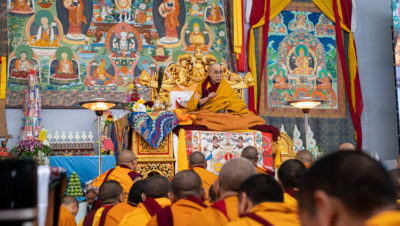
His Holiness the Dalai Lama addressing the crowd before resuming the Manjushri Cycle of Teachings at the Kalachakra Ground in Bodhgaya, Bihar, India on January 4, 2020. Photo by Tenzin Choejor
Manjushri Cycle of Teachings Resumes
January 4, 2020. Bodhgaya, Bihar, India – The weather over Bodhgaya turned cold again and a heavy mist hung in the air as His Holiness the Dalai Lama made his way to the Kalachakra Ground this morning. As is his custom, he took time to engage eye to eye with as many people as he could among those who lined his path. From the stage he waved to the audience and they waved back. He greeted various Lamas and other guests before climbing onto the throne. Before sitting down, he acknowledged the array of sacred paintings hung behind and around the stage.
Eight monks from the Royal Thai Monastery, led by their Abbot who is the senior Thai Elder in India, lost no time in taking their seats before the throne and reciting a section of the Mangala Sutta in Pali. They were followed by a group of ten, monks, nuns and laypeople, from Japan who chanted the ‘Heart Sutra’ in Japanese. After them came eleven Mongolians, monks, a nun and laypeople who chanted the ‘Heart of Wisdom’ again in Mongolian.
“Today, tomorrow and the day after,” His Holiness announced, “I’ll be giving permissions from the Manjushri Cycle of Teachings that we started last year. I hope to give what remains of the cycle this time.
“These teachings come down to us from Lama Umapa, Pawo Dorjé, who, even as a young boy herding sheep, had visions of Manjushri. I received the transmission from Tagdrak Rinpoché. ‘Homage to Manjushri, he with a youthful countenance, whose bright wisdom dispels the darkness of the three worlds.’ This doesn’t refer to physical darkness, but to ignorance.
“For followers of theistic religions faith in God is enough, but those of us who don’t believe in God need to use our intelligence to the full. Transforming our minds, we need to develop comprehensive, lucid, swift and profound wisdom. Practices to develop these wisdoms and enhance our intelligence include engaging in the study of philosophy on the basis of reason and logic, as the many monastics here from the Seats of Learning are doing.
“The Great Abbot Shantarakshita, the Adept Padmasambhava and the King Trisong Detsen introduced the Nalanda Tradition to Tibet. Keeping it up requires that we employ reason and logic—an approach preserved primarily among Tibetans. We examine our textbooks in the light of logic and then enter into argument and debate.
“While I do the preparatory rituals, you can recite the ‘ara patsa na’ mantra of Manjushri. Once I’ve given the first permission, I’ll follow the preparatory rites for the next one.
“These days, when I give empowerments and permissions such as these, the proceedings are webcast and available to people in far-off places. I’m giving these instructions with dedication and love. Those who watch online with faith and devotion can receive the transmission. At the time of the Buddha, there were occasions when the devout were unable to meet him in person and ordination was granted through the medium of a message. This provision in the Vinaya sets a positive precedent. This Manjushri Cycle of Teachings belongs to Highest Yoga Tantra and those who are not here, who watch with faith, can receive it too.
“Of course, we have found this human life and don’t wish to suffer. We want to be happy, but we don’t pay enough attention to what gives rise to suffering and how to overcome it. Nor do we think much about what the causes of happiness are. However, we have encountered the teachings of the Buddha, part of the Indian tradition, which prescribe means for disciplining our minds. The key issue is that whether we experience pain or pleasure depends largely on our state of mind.
“The sutras and tantras make clear that the chief cause of unhappiness is self-centredness, especially when combined with the misconception that people and phenomena are intrinsically existent. To counter these tendencies, we take refuge in the Buddha and follow what has also been revealed by Manjushri, Nagarjuna and his disciples, as well as Maitreya. They became enlightened by taking to heart what the Buddha taught. When I give people statues of the Buddha, I explain that he is our teacher. That makes us his students, so, we have to study.
“In the distant past, the Buddha cultivated the awakening mind of bodhichitta, then accumulated merit and wisdom for three countless aeons. Ultimately, he attained enlightenment in this special place. It’s a path we too can embark on now.”
The seventh permission in this cycle concerned White Tara, who, His Holiness remarked, is associated in the Guhyasamaja Tantra with motile energy. He also noted Drom-tön-pa had a special connection to her that also extends to the people of Tibet.
Tomorrow, His Holiness will give a Wrathful Female Deity Empowerment.
https://www.dalailama.com/news/2020/manjushri-cycle-of-teachings-resumes